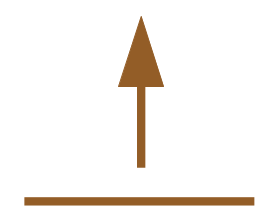The properties of converge series
$$ \forall a_n, \enspace \forall \lambda \in \hspace{0.04em} \mathbb{R},$$
-
If both series converge
$$ \forall \bigl(a_n, b_n\bigr),$$
-
If one of the series diverge
$$ \forall \bigl(a_n, b_n\bigr),$$
$$ \sum a_n \text{ converges and } \sum b_n \text{ diverges } \Longrightarrow \sum (a_n + b_n) \text{ diverges } $$
Let \((c_n, d_n)\) be two sequences having terms with a constant sign.
$$ \forall \bigl(c_n, d_n\bigr), \ l \in \mathbb{R}^*_+, $$
$$ \lim_{n \to + \infty} \left[ \frac{c_n}{d_n} \right] = l > 0 \Longrightarrow \text{\(\sum c_n\) et \(\sum d_n\) have the same nature} $$
Moreover, if \((l = 1)\) both sequences are equivalent, then:
$$ c_n \sim d_n \Longrightarrow \text{\(\sum c_n\) et \(\sum d_n\) have the same nature} $$
Demonstrations
Let \( \bigl(a_n, b_n\bigr) \) be two numerical sequences and \(\lambda \in \mathbb{R}\) a reel number.
If \(\sum a_n\) converge, that is to say that the series tends towards a certain limit \(l\):
$$ \exists! \ l, \in \mathbb{R}, \ \lim_{n \to + \infty} \sum a_n = l $$
Then, multiplying both sides by \(\lambda\), we do have:
$$ \lambda \lim_{n \to + \infty} \sum a_n = \lambda \ l $$
Now, the limit of a product is the product of the limits:
$$ \forall f, \ \forall \lambda \in \mathbb{R},$$
$$ lim (\lambda f) = \lambda \ lim (f)$$
Thus,
$$ \lambda \lim_{n \to + \infty} \sum a_n = \lim_{n \to + \infty} \biggl[ \lambda \sum a_n \biggr] = \lambda \ l $$
And we can put \(\lambda\) inside the sum,
$$ \lambda \lim_{n \to + \infty} \sum a_n = \lim_{n \to + \infty} \biggl[ \sum (\lambda \ a_n) \biggr] = \lambda \ l $$
Therefore, we obtain that \(\sum (\lambda \ a_n)\) converge towards \(\lambda \ l\).
And as a result,
$$ \forall a_n, \enspace \forall \lambda \in \hspace{0.04em} \mathbb{R},$$
-
If both series converge
In the same way as before, if \(\sum a_n\) and \(\sum b_n\) converge, then:
$$
\exists! \ (l, l') \in \hspace{0.04em} \mathbb{R}^2, \ \left \{ \begin{gather*}
\lim_{n \to + \infty} \sum a_n = l \\ \\
\lim_{n \to + \infty} \sum b_n = l'
\end{gather*} \right \}
$$
So by adding the two expressions, we have:
$$ \lim_{n \to + \infty} \sum a_n + \lim_{n \to + \infty} \sum b_n = l + l' $$
The limit of a sum being the sum of the limits:
$$ \forall (f, g),$$
$$ lim (f+g) = lim (f) + lim (g) $$
So now we have this:
$$ \lim_{n \to + \infty} \biggl[ \sum a_n + \sum b_n \biggr] = l + l' $$
$$ \lim_{n \to + \infty} \biggl[ \sum (a_n + b_n) \biggr] = l + l' $$
Therefore, we obtain that \(\sum (a_k + b_k) \) converge towards \((l + l')\).
So,
$$ \forall \bigl(a_n, b_n\bigr),$$
-
If one of the series diverge
If one of the series diverge, then:
$$
\exists! \ l \in \mathbb{R}, \ \left \{ \begin{gather*}
\lim_{n \to + \infty} \sum a_n = l \\ \\
\lim_{n \to + \infty} \sum b_n = + \infty
\end{gather*} \right \}
$$
So by adding the two expressions, we have:
$$ \lim_{n \to + \infty} \sum a_n + \lim_{n \to + \infty} \sum b_n = l + \bigl[ + \infty \bigr] $$
As above, we can arrange it like this:
$$ \lim_{n \to + \infty} \biggl[ \sum a_n + \sum b_n \biggr] = \underbrace{l + \bigl[ + \infty \bigr]} _{\bigl[ + \infty \bigr]} $$
$$ \lim_{n \to + \infty} \left[ \sum (a_n + b_n) \right] = + \infty $$
And finally,
$$ \forall \bigl(a_n, b_n\bigr),$$
$$ \sum a_n \text{ converges and } \sum b_n \text{ diverges } \Longrightarrow \sum (a_n + b_n) \text{ diverges } $$
Let \((c_n, d_n)\) be two sequences having terms with a constant sign and \(l \in \mathbb{R}^*_+ \) a real number such as:
$$ \lim_{n \to \infty} \left[ \frac{c_n}{d_n} \right] = l $$
Since both sequences have constant terms, then \((l > 0)\). Similarly, it is possible to find two real \((l_1, l_2)\) such as:
$$ l_1 < \frac{c_n}{d_n} < l_2 $$
By multiplying all terms by \(d_n\), we do obtain this:
$$ l_1 \ d_n < c_n < l_2 \ d_n $$
$$ \sum (l_1 \ d_n) < \sum c_n < \sum (l_2 \ d_n) $$
Now, we saw above a property which tells us that for a series associated with a sequence \((a_n)_{n \in \mathbb{N}}\)
$$ \sum a_n \text{ converges } \Longrightarrow \sum (\lambda \ a_n) \text{ converges } $$
-
if \(\sum d_n\) converge
If \(\sum d_n\) converge, then it is the same thing for \(\sum (l_2 \ d_n)\).
In addition to that, the series \(\sum c_n\) being lower than a convergent series, it also converges.
$$ \lim_{n \to + \infty} \left[ \frac{c_n}{d_n} \right] = l > 0 \Longrightarrow \text{\(\sum d_n\) converge \(\Longrightarrow \sum c_n\) converge} $$
-
if \(\sum d_n\) diverge
Likewise, if \(\sum d_n\) diverge, then it is the same thing for \(\sum (l_1 \ d_n)\).
In the same way, the series \(\sum c_n\) being greater than a divergent series, it also diverges.
$$ \lim_{n \to + \infty} \left[ \frac{c_n}{d_n} \right] = l > 0 \Longrightarrow \text{\(\sum d_n\) diverge \(\Longrightarrow \sum c_n\) diverge} $$
And as a result,
$$ \forall \bigl(c_n, d_n\bigr), \ l \in \mathbb{R}^*_+, $$
$$ \lim_{n \to + \infty} \left[ \frac{c_n}{d_n} \right] = l > 0 \Longrightarrow \text{\(\sum c_n\) et \(\sum d_n\) have the same nature} $$
Moreover, if \((l = 1)\) both sequences are equivalent:
$$ \lim_{n \to + \infty} \left[ \frac{c_n}{d_n} \right] = 1 \Longleftrightarrow c_n \sim d_n $$
We will have as a bonus:
$$ c_n \sim d_n \Longrightarrow \text{\(\sum c_n\) et \(\sum d_n\) have the same nature} $$




 Go to the top of the page
Go to the top of the page